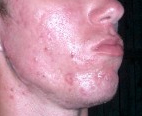What is Acne?
Acne vulgaris is a self-limited disorder primarily of teenagers and young adults, although perhaps 10 to 20% of adults may continue to experience some form of the disorder. The permissive factor for the expression of the disease in adolescence is the increase in sebum production by sebaceous glands after puberty. Small cysts, called comedones, form in hair follicles due to blockage of the follicular orifice by retention of sebum and keratinous material. The activity of bacteria (Proprionobacterium acnes) within the comedones releases free fatty acids from sebum, causes inflammation within the cyst, and results in rupture of the cyst wall. An inflammatory foreign-body reaction develops as a result of extrusion of oily and keratinous debris from the cyst.
The clinical hallmark of acne vulgaris is the comedone, which may be closed (whitehead) or open (blackhead). Closed comedones appear as 1- to 2-mm pebbly white papules, which are accentuated when the skin is stretched. They are the precursors of inflammatory lesions of acne vulgaris. The contents of closed comedones are not easily expressed. Open comedones, which rarely result in inflammatory acne lesions, have a large dilated follicular orifice and are filled with easily expressible oxidized, darkened, oily debris. Comedones are usually accompanied by inflammatory lesions: papules, pustules, or nodules.
The earliest lesions seen in early adolescence are generally mildly inflamed or noninflammatory comedones on the forehead. Subsequently, more typical inflammatory lesions develop on the cheeks, nose, and chin. The most common location for acne is the face, but involvement of the chest and back is not uncommon. Most disease remains mild and does not lead to scarring. However, a small number of patients develop large inflammatory cysts and nodules, which may drain and result in significant scarring.
Exogenous and endogenous factors can alter the expression of acne vulgaris. Friction and trauma may rupture preexisting microcomedones and elicit inflammatory acne lesions. This is commonly seen with headbands or chin straps of athletic helmets. Application of comedogenic topical agents in cosmetics or hair preparations or chronic topical exposure to certain industrial compounds that are comedogenic may elicit or aggravate acne. Glucocorticoids, applied topically or administered systemically in high doses, may also elicit acne. Other systemic medications such as lithium, isoniazid, halogens, phenytoin, and phenobarbital may produce acneiform eruptions, or aggravate preexisting acne
Harrisson - 16th edition

No comments:
Post a Comment